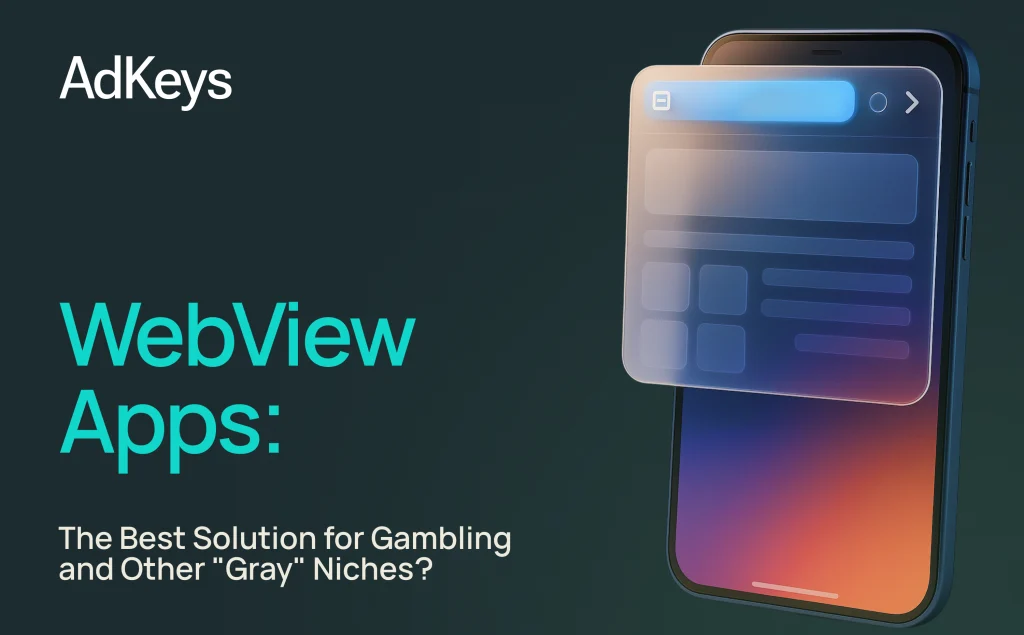
When it comes to promoting specific areas such as gambling and other “gray” niches, WebView apps are often in the spotlight. What are they and what are they good for? Let’s get to the bottom of it with AdKeys Digital team.
What is a WebView App?
WebView is the system component responsible for opening web pages directly inside apps. It is what you see when you open third-party links in messengers or social networks. In the promotion of gambling, betting, dealing and other “gray” niches, WebView apps are used to place links to offers and then place these apps in stores (Google Play, App Store) or on third-party lendings. This opens up a wide range of traffic sources.
Traffic Sources for Gambling Promotion with WebView Apps
In principle, any platform where app promotion is allowed is suitable. The most commonly used are:
- Facebook: Basic but difficult source due to strict moderation.
- Google UAC: Requires quality account warm-up, but provides quality traffic and wide reach.
- Other social networks: Instagram, VK, Telegram—testing advertising in various formats and promotion through Influencers.
- Video hosting: YouTube, TikTok—emphasis on bright emotions in creatives.
- In-App advertising: Attracting “warmed up” clients from apps with similar themes.
A wide range of traffic sources is not the only plus of WebView apps.
Advantages of WebView Apps for Gambling Promotion
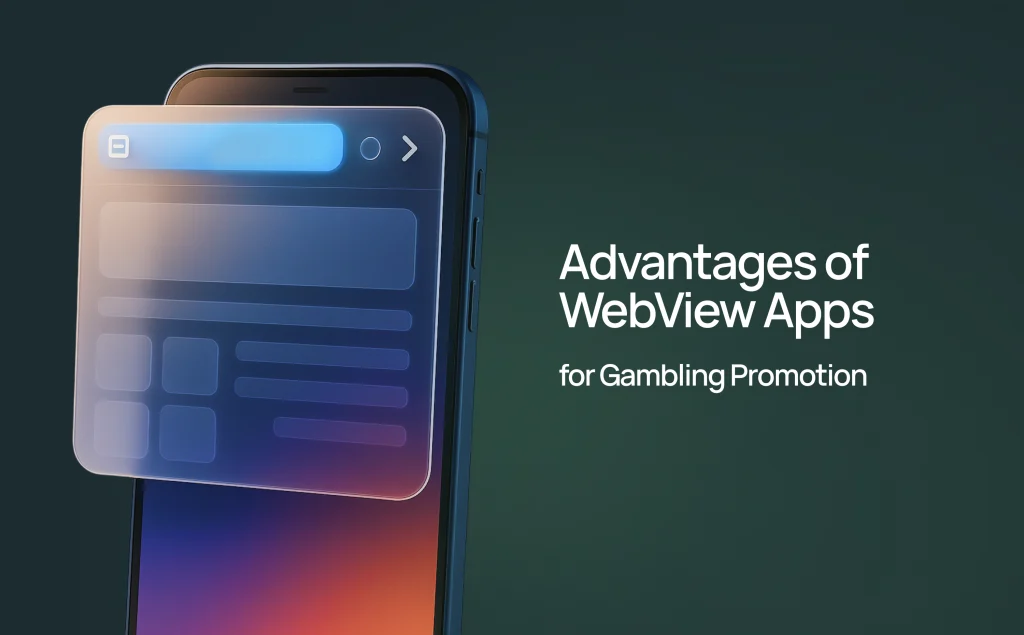
In addition to bypassing moderation, i.e. the ability to hide a “gray” offer behind a “white” plug, and additional advertising platforms, the following advantages of WebView can be noted:
- Detailed statistics thanks to the use of mobile trackers.
- Ability to conduct A/B-testing and segment the audience.
- Communication with users: it’s easy to build chat into the webview app.
- User trust: users trust apps from official stores.
- Increase engagement by connecting push notifications.
- Familiar interface: the WebView mechanism is familiar to users from messengers and social networks, so opening the browser inside the app does not cause rejection.
Of course, there are disadvantages to using WebView apps. First of all, these are difficulties in passing moderation—despite workarounds, there are no guarantees of success. Especially in the App Store, where moderation is tougher. Google Play is easier: it is quite willing to let an app through on automatic verification, but after manual verification there is still a high probability of blocking.
Even after successfully passing moderation, it is difficult to predict the life span of an app before it gets banned. On average, it ranges from 3 days to 3 weeks, but there are exceptions. The higher the volume of incoming traffic, the higher the risk of an app being detected due to the increasing number of checking bots, which become harder to identify.
We’ll talk more about how to increase app lifespan and reduce the risk of getting banned below. In the meantime, let’s take a closer look at the WebView app mechanism.
What Does a WebView App Consist of?
Stub or fake front (part of the app): The user-visible part of the application that masks “gray” content from moderators and untargeted audiences.
WebView (system component): An embedded browser that displays the target web page with the offerer.
Offer page: A web page with gambling, betting, action or other gray content.
Cloaker: A traffic filtering mechanism that shows a stub to moderators and bots, and a WebView with an offerer to target users.
How WebView App Works and Methods of Bypassing App Store Moderation
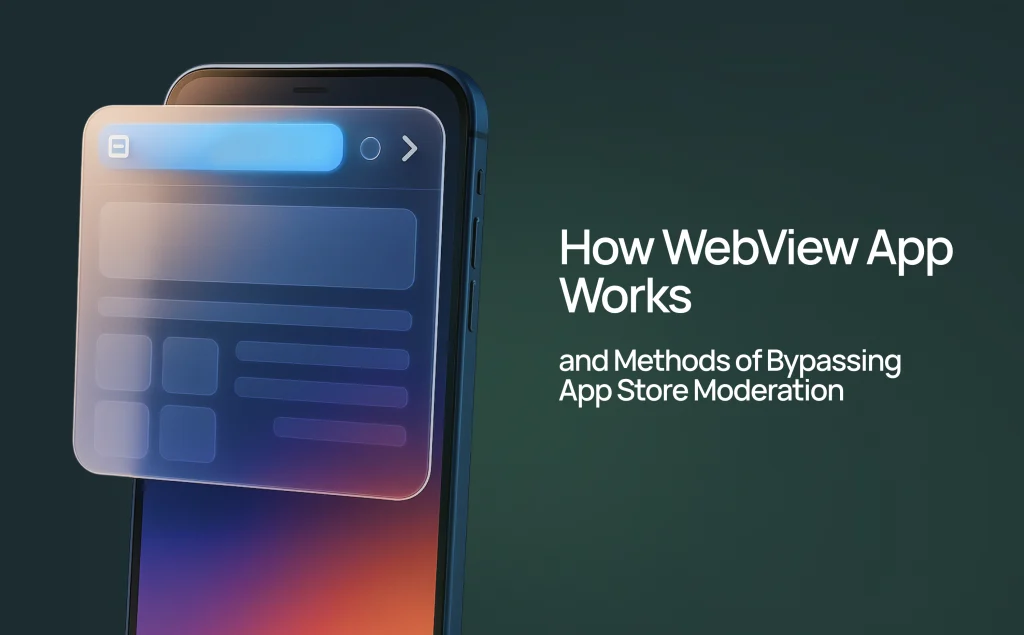
A developer places a link to an offer inside a WebView app. The app is uploaded to stores or distributed through other channels. The key element of moderation bypass is the stub. When moderators check the app, they see innocuous content (the stub). Target users, attracted by the advertisement, see a WebView with the desired offerer. Use various methods to identify moderators:
Identifying moderator IP addresses: if the IP belongs to a known range used by app stores, only “white” content is displayed.
Analyzing User-Agent (a string identifying the browser and operating system): if the User-Agent belongs to bots or moderation systems, a stub is shown.
Time delays: “gray” content may not be loaded immediately, but some time after installation or first launch, which may not be visible to moderators during a quick check.
User actions as a trigger. The display of “gray” content can be tied to certain user actions inside the app that moderators may not be able to perform during the check (e.g., clicking on a certain button, going to a certain section that is initially hidden).
Geotargeting: showing different content depending on the geographical location of the user. Moderators from countries with strict rules can see the “clean” version of the app.
In addition to moderators, developers can use similar techniques to filter untargeted traffic (e.g. bots of ad networks) and show them a stub to avoid suspicion and increase the quality of traffic for “gray” offers.
Thus, the WebView app works as a “wrapper” for a website, and moderation bypass techniques are aimed at making this “wrapper” look harmless to the store’s reviewing systems, but still deliver targeted “gray” content to interested users.
Stub—What to Look Out For and Where to Get One
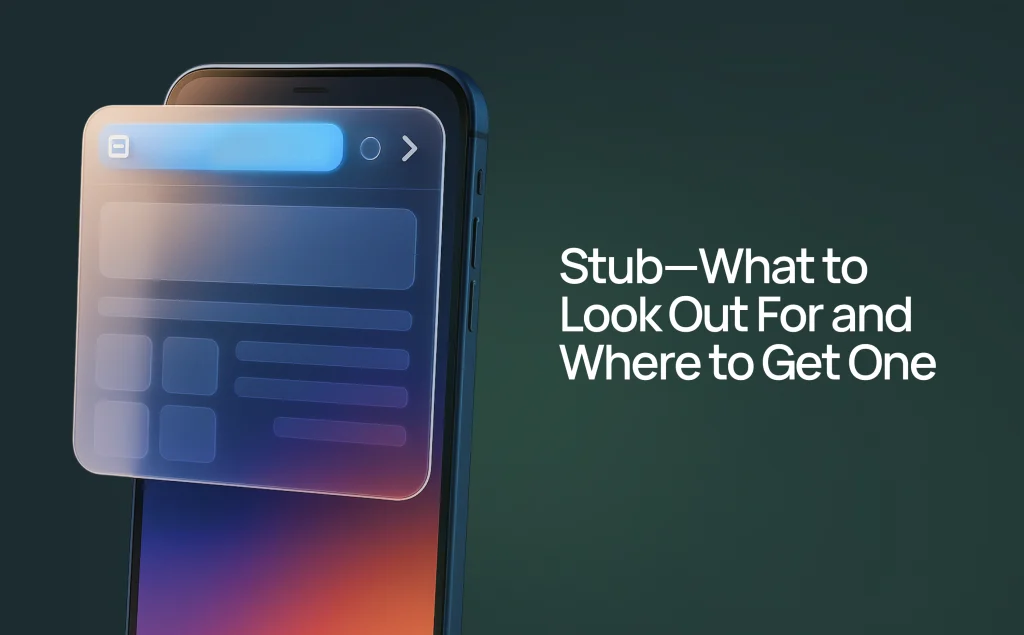
The stub plays a crucial role in successfully passing moderation. Its content depends on the vertical and app category requirements. It is desirable that it be as relevant as possible to the topic of the offerer so that users react positively to the content.
Examples of Stub Content:
Gambling: Arcade games, runners, three-in-a-row, platformers, tic-tac-toe.
Betting: Analytics readers, sports news apps, sports-themed games.
Dating: “Readers”, primitive “swipers” with photos.
Finance/Crypt: Apps about financial literacy.
Gut: “Readers” with useful information.
Where to Get a Stub:
Do-it-yourself: quick and easy with development experience.
Buy ready-made assets and remake them (reskin)
Order from a developer: specialists on freelance platforms can create custom stubs.
Rent: the risk of fraud, it is better to take in reliable services or partners.
It is important to be creative when creating a stub. It is recommended to add a main menu, a link to the privacy policy, as well as sounds and music for a better perception. The gameplay can be simple (e.g. catch objects, dodge, click), but the app should look complete.
It’s worth remembering that moderation on the App Store is much stricter than on Google Play. Can reject even white apps because of small things (typos, low resolution graphics, images with smoking). Developing a high-quality stub for iOS is more complicated and takes more time (on average 5-7 days with moderation) than for Android (a couple hours). A large set of graphics is needed to upload the app to the App Store. The design of the app should be maximally related to its content, preferably containing screenshots. Using cross-platform engines such as Unity makes development easier, but does not eliminate all the complexities.
The WebView App Itself—Where to Get It, What Might Be the Nuances
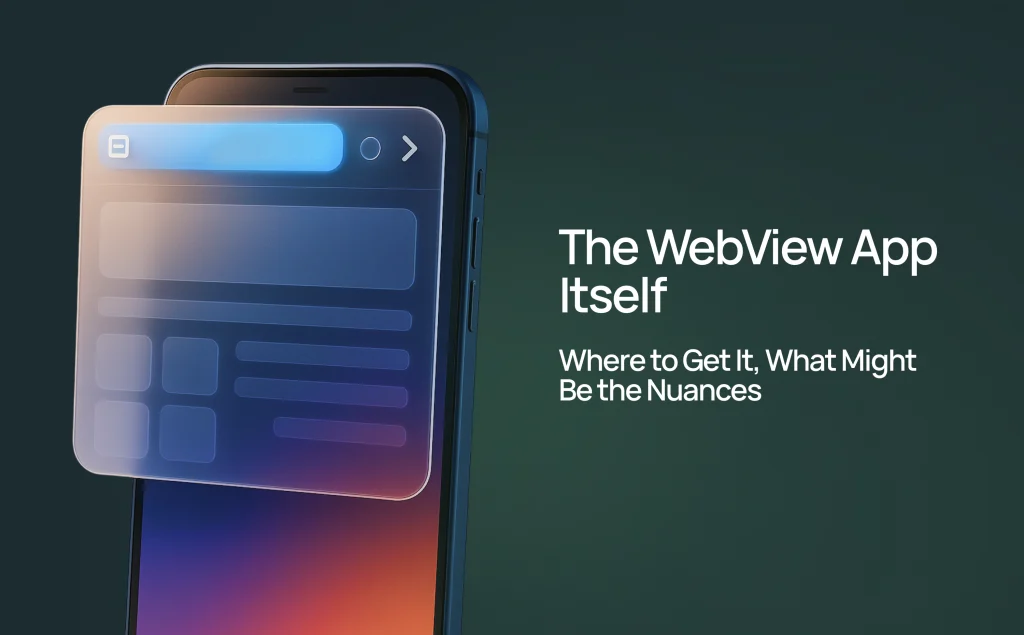
You can get a WebView app in the following ways:
1. Creating on a builder
There are a number of online platforms and services that offer WebView app builders. These tools usually have an intuitive interface that allows users without deep programming knowledge to create simple apps based on web links.
Advantages:
- No knowledge of programming languages is required.
- Speed: It can take just a few minutes to create a basic app.
- Low cost: many builders offer free or very cheap pricing plans for basic features.
- Ready-made templates: simplify the design process and can help you pass moderation faster (if the templates are “white-label”).
Disadvantages:
- Limited functionality: designers often offer a basic set of features, and it may not be possible to implement complex native functionality or deep device integration.
- Templateness: apps created on the same builder may look similar, which may make moderators or users suspicious.
- Less control over code: you don’t have direct access to the app’s source code, which limits your ability to customize and optimize it.
2. Development from scratch
Advantages:
- Possibility to realize any design and functionality.
- Uniqueness: it is possible to create a completely unique app, which will be more difficult to recognize as a “wrapper”.
- Flexibility: it is easy to make changes and adapt the application to changing requirements.
Disadvantages:
- High cost: developing from scratch requires significant time and cost, especially if experienced developers are involved.
- Long development time: the process of creating an app from scratch can take a significant amount of time.
3. Buying
There are quite a lot of offers on the market to sell ready-made WebView apps. These can be simple “wrappers” or more complex apps with a certain set of functions and settings to bypass moderation.
Benefits:
- Quick start: you get a ready-made solution and can start using it right away.
- Potentially advanced features: some pre-built apps may already have built-in cloaking tools and other useful features.
- Full control (if you purchase with source code): if you purchase an app with source code, you get full control over its further modification.
Disadvantages:
- High cost: off-the-shelf apps, especially those with advanced functionality, can be expensive.
- Security risks: If you buy an app from unverified vendors, you risk getting a low-quality or even malicious product.
- Lack of uniqueness: Off-the-shelf apps can be used by many people, which increases the risk of being detected and blocked.
4. Rental
Some services or private developers offer WebView apps for rent. This usually involves a monthly fee or payment for the number of installations. Rentals may include technical support and upgrades.
Advantages:
- Low cost: renting is usually cheaper than buying or developing from scratch.
- Quick access: you get a ready-to-use app.
- Technical support (in some cases): the lessor can provide support and handle updates.
Disadvantages:
- Limited control: you do not own the app and do not have full control over its functionality and code.
- Risk of unscrupulous landlords: there is a risk of encountering scammers who may redirect your traffic or provide inoperable apps.
- Possible limitations on functionality: rented apps may have limitations on the number of installations or other parameters.
- Security risks: As with a purchase, there is a risk of receiving an insecure app. It is crucial to choose reliable services with good reviews and check the reputation of the lessor.
When choosing how to obtain a WebView app, you need to consider your budget, technical skills, required functionality, desired level of control and risk tolerance. For beginners, building on a builder or renting may be more affordable options at the start, but more serious projects may require developing from scratch or purchasing from trusted sources. Either way, careful consideration of all the nuances and checking the reliability of the vendor are key.
Strategies to Protect Against WebView App Lockouts
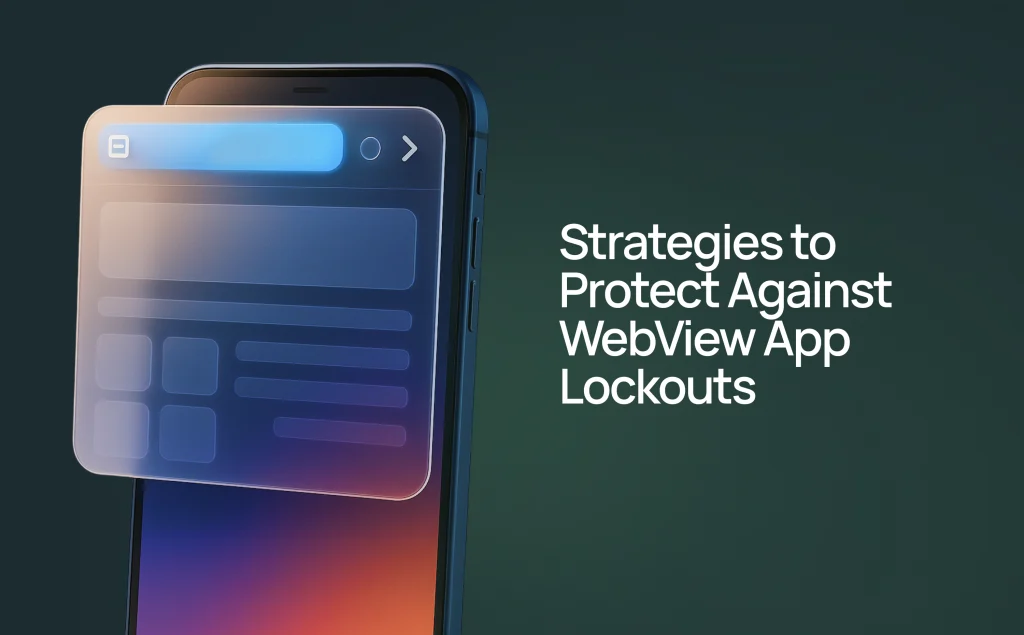
Blocking WebView apps in stores is a constant headache for those who use them to promote gambling and other “gray” niches. While there is no universal “silver bullet”, there are a number of solutions that can help maximize the life of apps and reduce the risk of banning:
- Regular updates to stub submissions. Moderators are constantly improving their detection algorithms. Using the same stubs for a long time makes apps more vulnerable. Regularly updating the design, functionality, and even the name of the stub can help “trick” moderators’ vigilance. The frequency of updates depends on the intensity of inspections and the lifespan of previous apps, but on average can range from a few weeks to a month.
- Vary the content within WebView. Even if the stub remains the same, you can periodically change the content of the target web page (offerer) or how it is displayed within WebView. This can make it difficult to automatically detect links between apps and prohibited content.
- Use of different developer accounts. Linking a large number of suspicious apps to a single developer account is a clear red flag for stores. Using multiple “warmed up” accounts with good reputations can reduce the risk of blocking an entire network of apps.
- Organic traffic and “trust building”. Attempting to mimic organic growth in installations and user activity can give the impression of a legitimate app. This may include using bots to mimic user activity initially or attracting a small number of real users through non-mainstream channels.
- Thorough testing prior to publication. Before submitting the app for moderation, it is necessary to thoroughly test all its functions, including WebView and cloaking mechanism, to make sure they are stable and work correctly in various scenarios.
- Analyze the reasons for rejections and bans. If an app has been rejected or banned, it is crucial to analyze the reason. Stores often indicate specific rule violations. Addressing these violations and adapting your strategy can increase the chances of success in the future.
- Use of “white” pads. Instead of a direct link to a “gray” offer, you can use intermediate web pages (“pads”) with neutral content, which then redirects the user to the target site. This can make it more difficult for moderators to track the final content.
- Geotargeting and timelines for gray content. Showing gray content only in certain regions or at certain times can reduce the risk of detection by moderators who are in other locations or checking apps at other times.
Outlook for WebView Technology
WebView technology, despite its simplicity and convenience in certain scenarios, is influenced by ever-changing app store policies and the evolution of web technologies.
Tightening regulations in the App Store and Google Play are a serious challenge to the use of WebView in gray niches. The trend is for stores to go for more native and controlled content. Going through moderation for WebView apps is getting steadily more difficult. The quality requirements for plugs are increasing.
In response to improvements in moderation algorithms, cloaking techniques are also evolving. Instead of simple User-Agent or IP address checks, more sophisticated systems are being developed to analyze behavioral factors and network traffic to identify moderators and bots. Multi-level cloaking is used, i.e. multiple stages of redirecting and showing different content depending on the “quality” of the traffic.
We can say that this is a constant “arms race” between developers and moderators and success in this area will depend on constant adaptation, search for new technical solutions and readiness for high risks of blocking.
Today, WebView apps continue to be a sought-after tool in attracting traffic for "gray" niches due to the ability to bypass moderation with the help of stubs and cloaking. However, success in this field requires a deep understanding of WebView principles, moderation peculiarities in different stores, as well as the ability to create high-quality and relevant stubs. Blocking risks remain high, especially on the App Store, so flexibility and finding new approaches are key to success.
Pavel Ilyukhin, Team Lead of Media Buying
